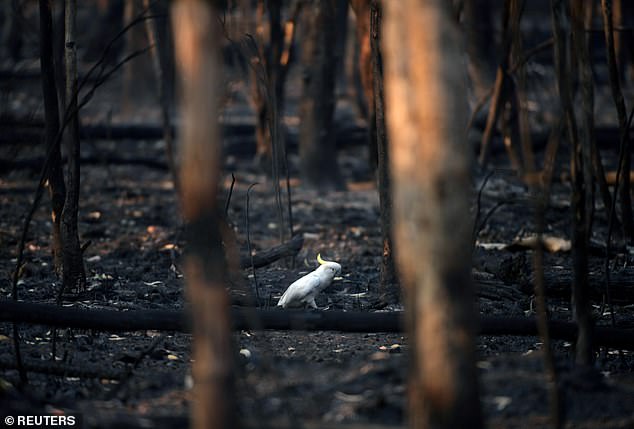[ad_1]
The cockatoos of hope: Endangered birds are spotted on Kangaroo Island after thousands of hectares of bushland were burnt in recent bushfires
- Cockatoos spotted on Kangaroo Island have sparked hope for endangered birds
- Three of the birds were found in nesting boxes having survived the bushfiresÂ
- 75 per cent of the species’ population lived within the 210,000 Hectares burnedÂ
- About 370Â were believed to have lived on the island prior to the recent firesÂ
Conservationists are hoping to find more endangered glossy-black cockatoos on burnt Kangaroo Island, after three were spotted in nesting boxes that survived the bushfires.
The species is only found on the island and up to 75 per cent of its population lived within the 210,000 hectares of land left charred by this summer’s inferno.
Karleah Berris from Natural Resources Kangaroo Island said staff found the birds in artificial boxes in the Lathami Conservation Park, on the island’s north coast.
‘It’s amazing to see these cockatoos trying to nest in this burnt area,’ she said.
‘Incredibly, there are healthy pockets of sheoak trees that survived the flames and they’re providing desperately-needed food for these birds.’
About 370 glossy black cockatoos were believed to have lived on the island prior to December 20, when the bushfires began.
The burnt area was home to 93 of 130 artificial nesting boxes, but staff are working with the World Wildlife Fund to assess the extent of the habitat damage.
‘Many of our cockatoo pairs rely entirely on artificial nesting boxes to breed, so it’s crucial for us to assess the damage and install new nests where there’s feeding habitat,’ Ms Berris said.

An injured cokatoo can be seen walking through kosciuszko National Park in January after the devastating bushfires in NSWÂ

Just like the cockatoos spotted in kosciuszko in January, the endangered glossy black species which have been spotted on Kangaroo Island provide hope to the populationÂ
The team is also monitoring cockatoos that escaped the fire to Cygnet Park, where several pairs were recently observed feeding and mating.
WWF-Australia’s head of Health Land and Seascapes Darren Grover said a group of up to 14 birds were seen in one tree at the park.
‘Some of them were initiating the early stages of breeding, which is amazing to see given the losses that Kangaroo Island and this species have endured over the past few months,’ he said.
He said the artificial nest boxes will prove essential during the cockatoos’ February to July breeding season.

Kangaroo Island sustained acres of damage as over half of the island was burnt by the devastating bushfiresÂ
Â
[ad_2]
Source link






